Abstract
Kabul River Basin is one of the most significant river basins in Afghanistan from a socio-economic perspective. Since the country is located in an arid climate zone with drastically varying climatic behavior, an effective assessment of meteorological drought is very essential to managing the limited availability of water resources. For this endeavor, the outputs of three general circulation models under two representative concentration pathways (RCP 4.5 and RCP 8.5) were used against the baseline period of 1961–1980. Different bias correction methods were applied, and the results show that the delta change method, quantile mapping method, and empirical quantile mapping all performed better for the precipitation, maximum temperature, and minimum temperature datasets, respectively. The ERA5-Land datasets and WorldClim Version 2 are used to validate the bias-corrected precipitation and temperature datasets, respectively, to determine their dependability, and the results were found to be promising. Standardized Precipitation Index (SPI), Reconnaissance Drought Index (RDI), Deciles Index (DI), and New Drought Index (NDI) were used to assess the drought condition in the past and forecast for the future periods of the 2020s, 2050s, and 2080s. The spatial distribution of assessed drought indices was mapped using the inverse distance weighting (IDW) method. Our results revealed that moderate to extreme droughts are consistent across the entire basin. This might be because the projected annual precipitation in the river basin shows a decline of 53–65% up to the end of this century (2100), and the average annual temperature is projected to increase by 1.8 °C, 3.5 °C, and 4.8 °C, respectively, for the three future periods of the 2020s, 2050s, and 2080s. Furthermore, the results show that the drought estimated by SPI and RDI for future climate scenarios is almost the same, whereas NDI estimates frequent drought events after the 2050s. However, for moderate drought, RDI, which includes the effects of evapotranspiration, was found to be far greater than SPI under both scenarios, and NDI considering temperature and precipitation also estimates a larger number of drought years, strengthening the possibility of its occurrence in the basin. A regional comparison of drought also indicates a decrease in precipitation in future periods, predominantly in high altitudes.
1. Introduction
Drought is a poorly understood and most complex natural hazard, especially in the Central and South regions of Asia [1]. The effects of drought can be further aggravated by a changing climate, leading to devastating adverse effects on the economic, social, cultural, and ecological sectors [1,2]. According to the American Meteorological Association (1997), drought is classified into four types: meteorological, hydrological, agricultural, and socioeconomic [3]. The first three categories examine the methods of measuring and evaluating the period of dehydration as a physical phenomenon, whereas the fourth one examines the period of water scarcity from the perspective of water supply and demand. It is highly evident and commonly agreed that climate change plays a vital role in causing drought due to the rising and declining of temperature and precipitation, respectively. Therefore, climate change and the resulting droughts are the biggest challenges in the present and future around the world. Incidents of this natural phenomenon all over the world have intensified the impacts since 1970. It was further reported that the drought in arid areas around the world has increased 1.5 times, and over 11 million people have lost their lives [4]. Drought further causes significant damage to all sectors; however, it is difficult to define, determine, and monitor without relating to meteorological phenomena [5]. Therefore, a comprehensive evaluation of drought, including the climate change impacts on the assessment of water resources available for long-term sustainability, is indispensable for the regions located in arid and semi-arid regions.
This study mainly focused on analyzing the meteorological drought in the Kabul River basin of Afghanistan. Since Afghanistan is in the central part of Asia and is primarily located in an arid region, droughts have threatened the country relentlessly throughout history. Overall, the country faces a negative impact on social, ecological, and socioeconomic developments [1]. Although it is one of the middle countries in greenhouse gas emissions, it is the most vulnerable country to climate change. It is particularly exposed largely to drought, floods, and landslides, and among them, the impact of drought is a serious concern. It has been warming by 0.6 °C since 1960 at an average rate of 0.13 °C per decade and is expected to rise from 1.4 to 4 °C by the 2060s. It is also estimated that a temperature rise will be about 2 to 6.2 °C by 2090 [6]. Moreover, Afghanistan’s average precipitation has decreased slightly since 1960 (by as much as 2% per decade). Recent findings show that a slight decrease in precipitation has been observed, especially in the spring [6]. Afghanistan is affected by monsoon droughts every year, and thus the effects of droughts are significant to human societies. The effects are continuing, and significant time is needed for the country’s water reserves to return to normal. In Afghanistan, where more than 80% of the population relies on agriculture and livestock, drought threatens livelihoods, lowers incomes, and challenges poverty alleviation. Drought in Afghanistan has had return periods of 10 to 15 years, with the 2018 drought being the most severe one. In the last few years, drought has affected more than two-thirds of the country’s total population in 34 provinces, of which 10.5 million were severely affected. In December 2018, among the total affected, 13.5 million people were in the most severe stage of food insecurity, and 300,000 people had been displaced to other locations. These droughts are marked as one of the most severe in recent decades in the country [7,8].
Several drought indices have been developed to assess different kinds of drought both spatially and temporally. The most commonly used indices are the Standardized Precipitation Index (SPI), Deciles Index (DI), Palmer Drought Severity Index (PDSI), Reconnaissance Drought Index (RDI), and Percent of Normal Precipitation Index (PNPI). Since each of the above indices has its strengths and weaknesses, the choice of the appropriate index is based on the data availability, purpose, and region of interest. However, among the several indices, SPI is the most frequently used index for assessing meteorological drought [1]. SPI was developed to quantify dryness and wetness and is currently being used for drought preparedness in more than 40 countries [9]. According to the monthly periods (3, 6, 9, and 12), SPI calculates the shortage of precipitation and, based on its values, defines the drought intensity. As SPI is calculated based on different durations, it can be used for different applications. For instance, the long-term accumulation periods of SPI are used for water supply and management, while the short-duration SPI is used for agricultural purposes. Calculated SPI values allow for determining the probability of precipitation, which is important to characterize the existing drought [10]. DI evaluates the long-term monthly precipitation from the highest to the lowest values and then determines the drought classes. The IPCC report indicated that the Earth’s surface temperature had been raised by 0.74 °C worldwide in the twentieth century, and global surface temperature is predicted to rise by 1.8 °C under RCP 4.5 by the end of this century. Therefore, it is very valuable and important to use drought indices, including temperature, to assess drought conditions under climate change scenarios [4]. It was also reported that the drought index must contain temperature data for analyzing different climate scenarios [11]. Jang, D. [12] assessed the meteorological drought in the future (2011–2100) using drought indices (SPI and RDI) under RCP 8.5 in Korea and found that the SPI estimated values show a humid climate in the future, while the RDI values show a dry climate as it takes the temperature into account. The results of the projection of drought under climate change scenarios in the south-west region of Pakistan [13], Nigeria [14], and Asian dryland [15], indicated that the temperature and evapotranspiration would increase, and a larger percentage of the region (Asian dryland) would experience significant drought. Assessment and projection of drought in the Jisha River Basin under climate change scenarios and drought indices by Yuan et al. [4] mentioned that the total drought area is projected to increase by 43.2% in the future period of 2021–2050. Moreover, the NDI, which is a new drought index, can also be used to assess the meteorological drought by considering the standardized values of precipitation and average air temperature for a certain period [16].
Even though droughts have been extensively studied using several indices for monitoring, only a very few studies have focused on modeling them for assessing future droughts in Afghanistan. The study by Alami et al. [1] in the Kabul River Basin used different drought indices such as SPI, DI, PNPI, and the China Z Index (CZI) for drought monitoring in the years 1979–2016. Results indicated that Gamma-SPI, Log-SPI, and DI could capture severe and extreme historical droughts successfully. Additionally, Baig et al. [9] performed research in the Chitral-Kabul River Basin to assess meteorological and hydrological drought using the Precipitation Condition Index (PCI), Vegetable Condition Index (VCI), Soil Moisture Condition Index (SMCI), Scaled Drought Condition Index (SDCI), and Microwave Integrated Drought Index (MIDI) for the historical periods of 2000–2018 and the future periods of 2020–2030. The result of this study indicated that the year 2018 was the driest year between 2000–2018. Another study by Abbas and Kousar [17] over the Indus River Basin for the spatial distribution of drought severity and magnitude during 1991–2017 using SPI and SDI drought indices in the Drin C model indicated that La Niña and El Niño have strongly correlated with drought. Their study also indicated that the SDI drought in 1991 and 2001 was severe. In all these research studies, meteorological and hydrological droughts have been evaluated using drought indices and hydrological models for the past few years and the next ten years (2020–2030). However, none of them have considered the impact of climate change, which is the primary cause of natural hazards.
Therefore, the main objective of this study is to forecast the meteorological drought in three future time intervals such as the 2020s (2010–2039), 2050s (2040–2069), and 2080s (2070–2099) by projecting climate change scenarios and focusing on drought indices such as SPI, RDI, DI, AI, and NDI in the Kabul River Basin, Afghanistan. This study comprehensively analyzed different bias correction methods to minimize the uncertainty in the future projected climate data. From the best knowledge of the authors, this is the first time that this study has forecasted the meteorological drought in the Kabul River Basin by considering the climate change scenarios and applying the best and most well-known methods and drought indices.
2. Study Area and Methodology
2.1. Study Area
This research was conducted in the Kabul River Basin, which is located between 33°29′ to 36°6′ N and 67°43′ to 71°40′ E in geographical coordinates of Afghanistan (Figure 1).
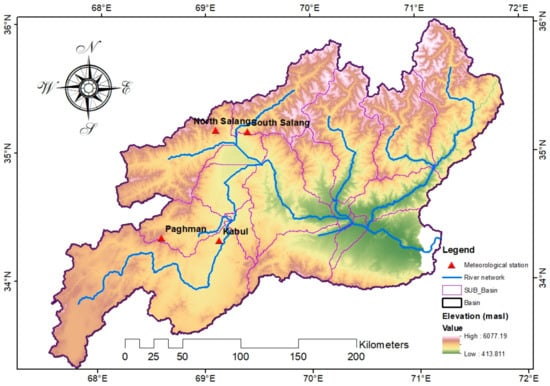
Figure 1.
Location map of Kabul River Basin with the meteorological stations used in this research.
The total length of the Kabul River Basin is 700 km, of which the majority of the flow occurs downstream of the catchment (i.e., 560 km) [18]. The total drainage area of this basin is 67,370 sq. km, which covers 12% of the total area of Afghanistan. The Kabul River Basin provides 26% of the total water resources in the country, with an average annual streamflow of 24 billion cubic meters. The flow direction in the basin is west to east, originating from the Paghman Mountains on the west and the Kohe Safi Mountains on the east, and is the primary source of freshwater [19]. This is the most important river basin, with a rate of 4% population increase per year during 2002–2007, and the rate of increase is expected to be even higher. This river basin contains 35% of the total population of the country, with a total population of 7,184,974 and a density of 93 people per sq. km. According to the projections of the United Nations, by 2057, the population of the basin will reach nine million. The climate of the basin is classified into cold winters (November–May) with extreme precipitation and hot summers (June–August) with very little or even no precipitation. Streamflow is generated mostly from the melting of glaciers or snow (the melting of permanent snow can create 72% of the total runoff). Due to the different elevations in this river basin, the amount of precipitation also varies considerably. Finally, the Kabul River Basin joins the Indus River Basin in Pakistan [19].
This paper used the monthly precipitation and temperature data observed from four weather stations for the years 1961–1980. The data were collected from the meteorological department of Kabul, Afghanistan. The monthly climate data were converted to a daily scale using the MODAWEC model. According to the classification by Bannayan and Hoogenboom (2008), the MODAWEC model is a parametric weather generator because it uses precipitation as the driving variable. Precipitation occurrence and amount are generated independently and other variables (e.g., temperature) are then generated based on the stochastically generated precipitation [20]. Due to the difference in altitude and different seasons, the temperature and precipitation vary throughout the river basin. The average annual precipitation, maximum temperature, minimum temperature, and mean temperature in the KRB are 690.3 mm, 12, 2.6, and 6.5 °C, respectively. The basin experiences its maximum temperature in June, July, and August, while the minimum temperature falls in November, December, January, and February. April is the wettest month observed in the whole area of the river basin. Figure 2 shows the average monthly maximum and minimum temperature in the KRB at different meteorological stations.
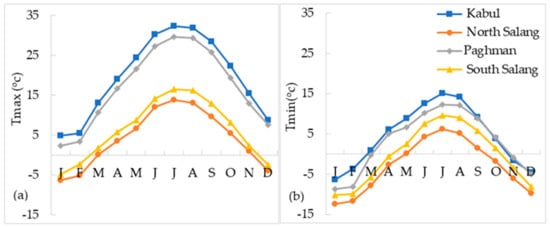
Figure 2.
(a,b) Distribution of average monthly maximum and minimum temperatures in Kabul Basin at different meteorological stations for the baseline period of 1961–1980.
To perform the analysis, the historical (1961–1980) and future (2010–2099) climate data (precipitation and temperature) of three general circulation models (GCMs) https://esgf-data.dkrz.de/projects/esgf-dkrz/ (accessed on 15 May 2022), ref. [21] were used. More details of the selected GCMs model are presented in Table 1.

Table 1.
GCMs and their features.
2.2. Methodology
As the main focus has been to assess the meteorological drought conditions under climate change scenarios, the delta change method (DC), quantile mapping (QM), and empirical quantile mapping (EQM) were used to bias correct the projected climate data, and the method that performed well was adopted for bias correcting the future climatic datasets. The reliability of the bias-corrected climatic datasets is examined by correlating the meteorological parameters with ERA5-Land and WorldClim gridded datasets. Projected climate data (maximum and minimum temperatures and precipitation) were used as input data into the Drin C model [24] to compute the drought indices (SPI, RDI, DI, and AI). Standardized values of precipitation and average maximum and minimum temperatures for the past and future periods were used to calculate the New Drought Index (NDI). The details of the drought indices are summarized below.
To analyze the spatial distribution of drought over the river basin, the inverse distance weighting (IDW) interpolation method was used along with Arc GIS 10.3. Figure 3 shows the overall framework of the methodology adopted in the paper.
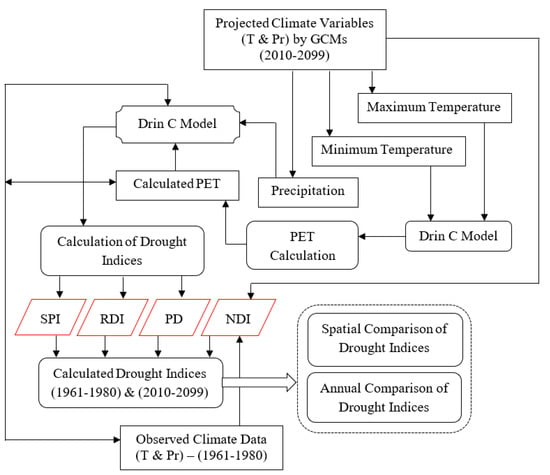
Figure 3.
Flowchart describing the adoption (The drought Indices used are placed in red color box).
2.2.1. Climate Change Scenario
Three GCM models that were built in the Coupled Model Intercomparison Project Phase 5 (CMIP5) were considered (Table 1). The basis of the selection of these models lies in having an acceptable level of resolution varying from 0.40° × 0.40° to 2.8° × 2.8° with vintages after 2010. Moreover, GCM models have been extensively used for studying the climate change impact in the region. In this study, two kinds of RCPs (RCP 4.5 and RCP 8.5) were considered to project the future climate data (2010–2099) with respect to the baseline (1961–1980). Radiative forcing is stabilized at 4.5 W/m2 in 2100 by RCP 4.5 without exceeding that value, and a radiative forcing pathway leading to 8.5 W/m2 by 2100 is raised by RCP 8.5. These RCPs are made from a range of greenhouse gas emission scenarios with or without climate policies. RCP 2.6 is the low emission scenario, which leads to a very low forcing level. If the proper mitigation strategies and efforts are made for reducing greenhouse emissions, then it is possible to achieve RCP 2.6. If proper adaptation strategies are implemented, then these two RCPs (RCP 4.5 and RCP 6), which are the intermediate stabilization scenarios, can be achieved. If no effort or little effort is taken to reduce the emission of greenhouse gases, RCP 8.5 pathways will arise [19]. The climate would change even if strong measures were taken in the future. Under these statutes, either adaptation strategies will be formulated and implemented to reduce the impact of climate change or no efforts will be made to reduce greenhouse emissions in the future. Therefore, to study the impact of climate change in the future with or without adaptation strategies, RCP 4.5 and RCP 8.5 were selected for this study. The future periods of the RCPs are divided into three time intervals: the 2020s (2010–2039), 2050s (2040–2069), and 2080s (2070–2099).
Due to their limited resolution, measured and projected data from general circulation models cannot be utilized directly to study climate change on a small or local scale [25]. To circumvent this issue, the output data of the models were downscaled via the delta change approach, quantile mapping, and empirical quantile mapping. These methods use the differences between the current simulated and observed data to correct the future climate data of GCMs. The delta change method can be calculated based on Equations (1)–(4).
where P and F show the present and future periods, respectively. The future scenarios are then generated using Equations (3) and (4).
where Fs (T) refers to future temperature, Fs (PPT) is used for future precipitation, and PPT is used for precipitation.
Tf = T (GCM simulated)f − T (GCM simulated)p
Pf = PPT (GCM simulated)f − PPT (GCM simulated)p
Fs (T) = T (Baseline) + Tf
Fs (PPT) = PPT (Baseline) × Pf
Quantile mapping corrects the regional climatic models by considering the quantiles between the observed and simulated datasets (Equation (5)).
where is the bias-corrected data and is the simulated data at the time interval ‘t’. is the cumulative distribution function, and is the inverse cumulative distribution function [26].
Empirical quantile mapping is a nonparametric method that employs the empirical cumulative distribution function (ECDF), obtained by comparing the quantiles of the simulated datasets with the observed datasets during validation (Equation (6)).
where is the cumulative distribution function, and is the inverse cumulative distribution function obtained during the training period, respectively [27].
The best GCM models were selected based on the statistical analysis (coefficient of determination, R2, and root mean square error, RMSE). According to this, the average monthly values of R2 and RMSE were calculated between the meteorological parameters of the GCM models and the baseline data of 1971–1980. Then, these values are compared to the bias-corrected weather parameters for the same time period. Further, statistical analysis is performed between the ERA5-Land precipitation and WorldClim temperature datasets and the bias-corrected precipitation and temperature datasets to validate the reliability.
2.2.2. Standardized Precipitation Index (SPI)
The SPI index, which was developed by Mckee et al. [28], is one of the most widely used and easiest methods for estimating the meteorological drought severity. The calculation of this index is based on the long-term precipitation data series for a particular duration (one, three, six, and twelve months) to facilitate the assessment of the effects of a precipitation deficit on different water resources components such as groundwater, soil moisture, reservoir storage, and stream flow. The estimated SPI index is not affected by the missing values in the data series. Using the data, the parameters of the Pearson Type-III distribution are estimated, and thus, the calculation of the cumulative probability drought index is applied to the standard normal distribution. The long-term data are fitted into the gamma probability distribution, which is converted to the normal distribution with a mean of zero and a unit variance. The positive and negative SPI values signify wet and dry periods, respectively. There are three types of widely used SPI distributions: gamma SPI distribution, log normal SPI, and normal SPI. SPI is easier to use than some other drought indices because it only needs a single series of long-term rainfall data as an input. Since it is based on normalized data, the SPI is spatially invariant, and drought can be assessed in different regions [28]. Equation (7) can be referred to for the SPI calculation, in which xi is the precipitation of the selected period during the year i, is the long-term mean precipitation, and is the standard deviation for the selected period.
The severity of the drought obtained from the drought indices (SPI and RDI) is shown in Table 2.

Table 2.
Classification of drought index based on SPI and RDI [28].
The definition of drought thus far has included a beginning date, an ending date, and current drought intensity. Drought duration can be measured from the beginning of a current drought event or from the beginning to the end of a historical drought event. Drought duration can also be counted as the number of months in drought conditions. The SPI index can easily determine the peak intensity of drought. A measure of the accumulated magnitude of the drought can be included. Equation (8) defines the magnitude of drought (DM) [13].
where j shows the drought months (1 − x) for any time scale (i). The units of DM are months and are numerically equivalent to drought if, in each month of the drought, the SPI value is equal to 1.0 [13]. Many droughts have a DM very similar to the duration in months since most of the SPI values are between 0 and −2. Additionally, the frequency of drought can be defined as the number of drought events that occurred.
2.2.3. Reclamation Drought Index (RDI)
This index, which was presented by Weghorst [29], is similar to the surface water storage index. The RDI is one of the most widely used indices due to its high sensitivity and flexibility. It is calculated based on climatic and meteorological factors, including river water level, snowfall, surface currents, water reserves, and temperature, and is used on a monthly time scale. For illustrative purposes, the yearly expressions are presented first. The first expression is called the initial value of RDI (α0) and is presented in aggregated form using a monthly time step. It may be calculated for each month of the hydrological year or for the complete year [30]. The α0 is usually calculated for the ith year on an annual basis using the following equation:
where PETij and Pij are the potential evapotranspiration and precipitation of the jth months of the ith year, usually starting from October, as it is common in Mediterranean countries, and the total number of years of available data is shown by N [30].
The second expression, the normalized RDI (RDIn), is calculated using the following equation for each year, in which it is clear that the 0 parameter is the arithmetic mean of α0 values calculated for the N year of data.
The below expression, the Standardized RDI (RDIst), is computed following a similar procedure to the one that is used for the calculation of the SPI. The expression for the standardized RDI is:
In which, yi is the ln( is the arithmetic mean, and is its standard deviation.
It is noted that the above expression assumes that the α0 values follow a lognormal distribution. The standardized RDI behaves similarly to the SPI, as does the interpretation of results. Therefore, the RDI can be compared to the same thresholds as the SPI. The classification of drought based on RDI values is presented in Table 2.
2.2.4. Deciles Index (DI)
One of the simplest indicators of meteorological drought is the Deciles method, introduced by Gibbs and Maher [31]. This index is very important for quantifying and monitoring drought as it estimates an accurate statistical measurement of precipitation provided long climatic data are available, especially monthly historical precipitation data. Total precipitation for the past three months is compared to climatic records. If this amount is in the lowest decile of the historical distribution for the whole three months, the region is considered to be under drought conditions [32].
The drought ends when:
- (i)
- Precipitation measured during previous months has placed the total of three months in the fourth decile or higher, or
- (ii)
- Total precipitation in the last three months is in the eighth decile or higher.
The advantage of this method is its computational ease. To construct the cumulative frequency distribution, the long-term monthly precipitation is ranked from highest to lowest. Based on the equal probabilities, the deciles are divided into ten parts (1–10%). As shown in Table 3, deciles are classified into five categories [1].

Table 3.
Classification of Deciles drought ranking [24].
To facilitate and expedite the computational process of drought indices (SPI, RDI, and DI), Drin C software was used in this paper. This software was developed at the Laboratory of Reclamation Works and Water Resources Management of the National Technical University of Athens and aims to provide drought indices suitable for all kinds of drought analysis [33].
2.2.5. Aridity Index (AI)
The aridity index is a numerical indicator that is used to measure the degree of dryness of a place. It is calculated based on the ratio of (P/PET), where P is the average annual precipitation and PET is the potential evapotranspiration [34]. Table 4 indicates different types of climates for a place according to the AI index. The formula of the aridity index is:

Table 4.
Classification of climate based on aridity index [25].
2.2.6. New Drought Index (NDI)
A new drought index can be calculated based on standardized values of precipitation and average maximum and minimum temperatures for a specific period. The standardized value is calculated by subtracting the average value of each period from each measured value and dividing the obtained value by the standard deviation of the sample. Then, NDI is calculated by subtracting the standardized temperature value from the standardized precipitation value. Temperature and precipitation are the two most important parameters of the climate, and their values play a vital role in determining all drought characteristics, such as duration, severity, intensity, and the beginning and end of the drought. The NDI method gives a very good result for drought estimation [16]. In the precipitation case, the intensity of the above-mentioned features is influenced by their deficit; in the case of temperature, it is influenced by temperatures higher than the average of the analysis period. Equation (13) indicates the method of NDI calculation.
where Pi is precipitation in the year or month (i). Pavg is the average value of the analyzed series of precipitation in the analysis period. Sp shows the standard deviation of the analyzed series of precipitation in the analysis period, and Ti is the mean temperature in a year or month [16].
2.2.7. Estimation of PET
To assess drought using the RDI index, potential evapotranspiration (PET) should first be calculated. To calculate PET in the Drin C model, there are three methods (Hargreaves, Thornthewait, and Blaney—Criddle). In this study, the Hargreaves method was chosen to calculate PET using climate parameters (maximum and minimum temperature). This method [34] is ranked as the highest among all methods, which are based on air temperature only and are widely used for limited climatological data. This method is mostly used for the predictions of ET0 for different periods and various purposes. Its ease of computation, minimum data requirement, low impact on air station aridity, and simplicity made it a very reliable method [35].
Reference evapotranspiration is defined as the potential evapotranspiration that happens under the hypothetical surface of green grass with a uniform, active growing height and is adequately watered [36]. The Hargreaves method is preferred over the Penman-Monteith method [35] when the availability of various meteorological data is limited. Equation (14) indicates the 1985 Hargreaves method.
where ET0 is the reference evapotranspiration (mm/d), 0.0023 is the empirical Hargreaves Coefficient (HC), Ra is the extraterrestrial radiation, TC is the temperature in degrees Celsius, 17.8 is the empirical temperature Hargreaves Constant (TH), TR is the temperature range (TR = Tmax − Tmin), and 0.5 is the empirical Hargreaves exponent [35].
2.2.8. Inverse Distance Weighting (IDW)
Spatial interpolation is one of the widely adopted methodologies to determine the unknown values that lie between a set of known points. In other words, interpolation can be defined as the method of fitting the data points to the value function. It is achieved by establishing a relationship between the known values. There are several types of interpolation methods available, and it is necessary to opt for an interpolation technique based on the terrain and topographical conditions [37]. In the present study, the inverse distance weighted (IDW) interpolation method was used to prepare the spatial map showing the variation of drought in the river basin. In the IDW method, the values near the measured locations will have more influence but diminish with distance. If the two values are closer to zero distance weighted, the model’s accuracy will be high. While the calculation is similar to kriging, the inverse distance weighted method follows the assumption that a value of an attribute at an unsampled location is a weighted average of known data points within a local neighborhood surrounding the unsampled location. The formula for this exact interpolator is [38].
where X0 is the estimation of the point and Xi are the data points within a chosen neighborhood. The weights (r) are related to distance by dij, which is the distance between the data points and the estimation points.
3. Results
3.1. Assessment of Drought for the Historical Periods
To assess the drought in the historical period, the observed data (1961–1980) of four meteorological stations in the KRB were used. The PET was calculated using climatic data from the Drin C model, and then the drought indices were estimated. Figure 4 illustrates the evapotranspiration results at Kabul, Paghman, South Salang, and North Salang stations. The results indicate that all stations had the highest amount of PET in 1970–1971, especially Kabul station (with a PET of 1400 mm), which is located at the lowest altitude. This is mainly because the temperature is higher at low altitudes than at high altitudes, and evapotranspiration can be directly related to the temperature. In other words, the lowest PET was recorded at the North Salang station, which has a high altitude. Analysis of all stations shows that the amount of PET increased during the 1961–1980 years, which indicates a rise in temperature in this river basin since both factors are inextricably linked.
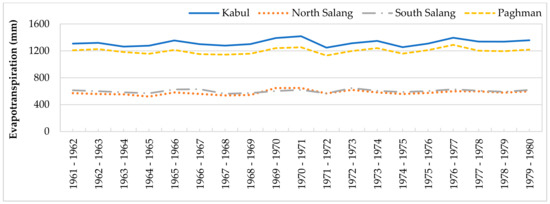
Figure 4.
The PET was calculated for the baseline period of 1961–1980 at different stations in the Kabul River Basin.
According to the annual analysis of the SPI index during twenty years, drought events occurred with a frequency of twice in the years 1968–1971 and 1973–1979, with a duration of 48 and 84 months, respectively. As shown in Figure 5, the years 1970 and 1971 were the driest years with an average value of (−1.35), while the wettest years were 1964 and 1965 with an average value of (1.5). Kabul station experienced moderate droughts in the years 1961–1962, 1969–1970, and severe droughts in the years 1976–1977 and 1973–1974. There was a severe drought at Paghman Station in the years 1973–1974. South Salang also witnessed extreme drought in the years 1976–1977. These two stations (North Salang and South Salang), which are located at a higher altitude, have experienced less drought compared to other stations based on SPI calculations.

Figure 5.
SPI was estimated for the baseline period of 1961–1980 at different stations in the Kabul River Basin.
In addition, according to the annual results of the RDI index during the twenty years in this river basin, drought events occurred with a frequency of twice in the years 1968–1971 and 1973–1979, with a duration of 48 and 84 months, respectively. Since the RDI index takes into account the temperature, the results show that the duration of drought is longer than SPI results. Moreover, according to Figure 6, the wet periods are less than the SPI results. North Salang and South Salang suffered from severe droughts in the years 1970–1971 and 1976–1977, respectively. Additionally, Kabul and Paghman stations also experienced severe droughts in the years 1973–1974. Based on RDI results, the driest years in this river basin are 1976–1977 with an average value of (−1.28), while the wettest year was recorded in the years 1964–1965 with an average value of (1.23).
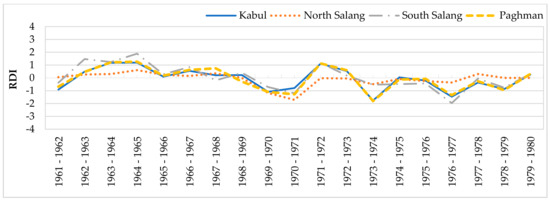
Figure 6.
RDI was estimated for the baseline period of 1961–1980 at different stations in the Kabul River Basin.
The results of deciles and threshold ranges for all stations are presented in Table 5. According to the results, drought has occurred at Kabul, North Salang, South Salang, and Paghman stations when the precipitation was less than 297 mm/year, 997 mm/year, 972.9 mm/year, and 415 mm/year, respectively. Kabul and Paghman stations suffered from severe drought in the years 1961–1962, and 1978–1979, and extreme drought during the years 1973–1974. Additionally, there was an extreme drought at all stations in the years 1969–1970 and 1976–1977, except at the South Salang and North Salang stations, respectively. Furthermore, South Salang station experienced severe droughts during the 1967–1968 years, while there was a severe and extreme drought in South Salang and North Salang stations during the 1973–1974 and 1978–1979 years, respectively. As shown in Figure 7, the Deciles index indicates more severe and extreme drought conditions than the SPI and RDI results.

Table 5.
Results of Deciles for all stations for the baseline period of 1961–1980.
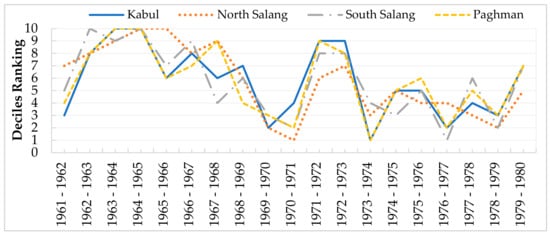
Figure 7.
Deciles ranking for the baseline period of 1961–1980 at different stations in the Kabul River Basin.
Based on the NDI analysis performed over the Kabul River Basin from 1961 to 1918, it is evident that drought events were experienced twice between 1969 –1971 and 1977–1979. Figure 8 shows the NDI obtained for the four observatories located along the Kabul River Basin using temperature and precipitation as the primary inputs. Analyzing the NDI obtained for individual stations, it is identified that all the stations experienced drought since 1969 for a period of 48 months. Kabul and Paghman, located in the southern part of the basin, experienced drought conditions in 1962 and 1966, respectively. Similarly, in 1973, South Salang experienced a drought event. Since 1977, all stations have experienced drought, with North Salang experiencing a severe drought in 1979 with an NDI value of 3.71. The wettest years were 1964, 1965, 1967, and 1972, when all stations recorded NDI values greater than one.
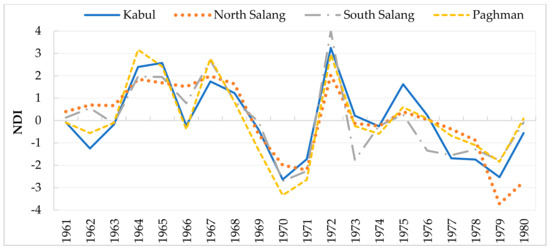
Figure 8.
NDI for the baseline period of 1961–1980 at different stations in the Kabul River Basin.
The results of the occurrences of drought in all meteorological stations based on the SPI, RDI, and NDI indexes are presented in Table 6. From these values, it is clear that all stations have experienced moderate drought, notably Paghman station. Although SPI did not take into account the temperature, it indicated more drought (extreme) in the stations of Kabul and South Salang. Based on the NDI considering temperature and precipitation, it is clear that all the stations experience moderate and severe drought, whereas North Salang and Paghman experience extreme drought conditions.

Table 6.
Number of occurrences of drought in each station for the baseline periods of 1961–1980 in the Kabul River Basin.
3.2. Bias Correction of Climate Data
Comparing the R2 and RMSE values obtained from different bias correction methods, it is evident that all the bias correction methods provide similar results with a minor variation. Analyzing the maximum R2 and minimum RMSE values, the bias correction methods such as DC, QM, and EQM were identified as the best suitable for precipitation, maximum temperature, and minimum temperature, respectively. Therefore, the DC-based bias-corrected precipitation, QM-based bias-corrected maximum temperature, and EQM-based bias-corrected minimum temperature can be used effectively over the Kabul River Basin. A comparison of the R2 and RMSE obtained from statistical values of the meteorological parameters before and after bias correction shows satisfactory results. Table 7 presents the mean values of R2 and RMSE for maximum and minimum temperature and precipitation in all three GCMs at each of the four stations in the Kabul River Basin.

Table 7.
Summary of the statistics for baseline and simulated temperatures, and precipitation at four meteorological stations in the Kabul River Basin for the baseline period 1961–1980, before and after bias correction.
European Centre for Medium-Range Weather Forecasts (ECMWF) ERA5-Land precipitation data is obtained over the Kabul River Basin to validate the bias-corrected precipitation datasets. With a mean R2 value of 0.962, 0.964, and 0.967 for the delta change, EQM, and QM approaches, respectively, the results from comparing the bias-corrected and ERA5-Land precipitation data seem promising. The datasets also recorded a mean RMSE variation of 0.143, 0.141, and 0.137 for delta change, EQM, and QM methods, respectively. The variation of the ERA5-Land datasets in comparison with the bias-corrected precipitation data is presented in Table 8. Similarly, WorldClim version 2.1 temperature data is utilized to validate the bias-corrected temperature datasets. The R2 and RMSE of the bias-corrected minimum and maximum temperature are reported to be within the acceptable limits and are presented in Table 8. Based on the validation performed using the ELA5 and WorldClim datasets, it is suggested that the bias-corrected precipitation and temperature data can be utilized for analysis over the Kabul River basin.

Table 8.
Comparison of bias-corrected data with ERA5-Land precipitation and WorldClim temperature datasets.
3.3. Projection of Climate Change Scenarios
To assess the changes in maximum and minimum temperature in the future (2010–2099), the downscaled data of three GCM models under two emission scenarios (RCP 4.5 and RCP 8.5) were used. Figure 9 represents the average annual temperature in the whole Kabul River Basin relative to the baseline period of 1961–1980 under RCP 4.5 and RCP 8.5 scenarios. The average annual temperature is expected to rise under both RCPs in the three future periods of the 2020s (2010–2039), 2050s (2040–2069), and 2080s (2070–2099) by 1.8 °C, 3.5 °C, and 4.8 °C, respectively.

Figure 9.
Simulated average annual temperature for the future periods of 2010–2099 relative to the baseline period of 1961–1980 under RCP 4.5 and RCP 8.5 scenarios in the Kabul River Basin.
Analysis of precipitation in the future periods of the 2020s, 2050s, and 2080s based on two scenarios (RCP 4.5 and RCP 8.5) shows that the amount of monthly precipitation is likely to change significantly. The wettest month of April has shifted to March. Additionally, under both scenarios, there was a decrease in precipitation of about 60 mm, and 80 mm for the 2020s and 2080s, respectively. According to the baseline period of 1961–1980, April was the wettest month with precipitation of 173 mm, and a sharp drop in precipitation was not noticed in the projected values for the same month. Fewer changes were noted in January, February, October, and December under both emission scenarios. Results also indicate that most of the months can be in drought situations. Figure 10 represents the annual precipitation under both scenarios. Based on this, RCP 4.5 is projected to have higher precipitation in the years 2091–2099 than RCP 8.5. Overall, there is a decrease in precipitation in the future periods of 2010–2099, which may cause water stress in the whole area of the Kabul River Basin in the future.
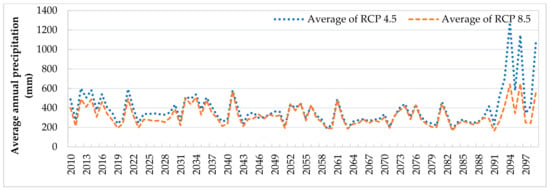
Figure 10.
Simulated average annual precipitation for the future periods of 2010–2099 relative to the baseline period of 1961–1980 under RCP 4.5 and RCP 8.5 scenarios in the Kabul River Basin.
3.4. Projection of Drought in the Future
To project the drought into the future, first, the PET needs to be calculated. Figure 11 shows the result of evapotranspiration in the whole area of the Kabul River Basin estimated by the Hargreaves method using the projected data of RCP 4.5 and RCP 8.5 scenarios in the three future periods of the 2020s, 2050s, and 2080s. In all three periods, the evapotranspiration rises over time, but with a decline of 159 mm, 69 mm, and 216.8 mm under RCP 4.5 and 160.2 mm, 101.3 mm, and 199 mm under RCP 8.5 during the years 2026–2027, 2044–2045, and 2080–2081 in the three future periods of the 2020s, 2050s, and 2080s, respectively. Based on both RCPs, simulated evapotranspiration shows a similar trend in temperature, which can be interpreted as the rising effect of temperatures.
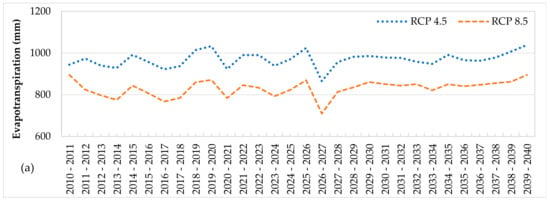
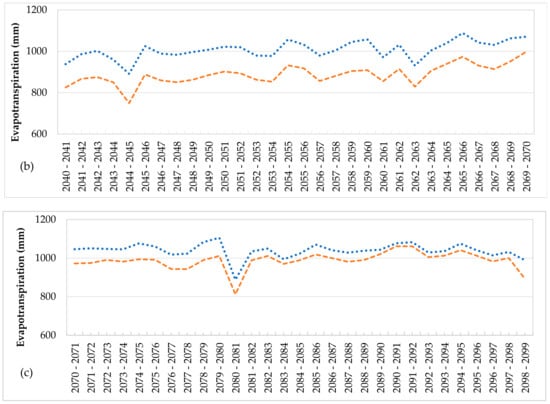
Figure 11.
(a–c) Average annual evapotranspiration calculated with the RCP 4.5 and RCP 8.5 in the Kabul River Basin.
Table 9 presents the geographical locations of meteorological stations and the statistics of the aridity index and the amount of average annual evapotranspiration calculated by RCP 4.5 and RCP 8.5 scenarios for the future periods 2010–2099.

Table 9.
Summary statistics of aridity index and projected average annual values of PET under RCP 4.5 and RCP 8.5 for the future periods of 2010–2099.
3.4.1. Calculation and Analysis of SPI, RDI, DI, and NDI
In this section, future drought analysis based on two emission scenarios (RCP 4.5 and RCP 8.5) using SPI, RDI, and DI on an annual basis was assessed. To discover the SPI, RDI, and DI, the Drin C model was used with the meteorological data obtained from four stations consisting of climate factors (temperature and precipitation) and latitude. Figure 12 indicates the results of the average values of SPI from four meteorological stations that used average monthly precipitation values and latitude coordinates. Analysis of SPI values under two emission scenarios shows that the SPI value decreases gradually, especially at high altitudes (North Salang and South Salang stations), but increases sharply at low elevations (Kabul station and Paghman station) at the end of the century. On average, the Kabul River Basin will experience moderate and severe droughts in three future periods (the 2020s, 2050s, and 2080s) under both scenarios. Under RCP 4.5, moderate drought years will likely happen in the years 2018–2019, 2019–2020, 2025–2026, 2045–2046, 2058–2059, 2059–2060, 2082–2083, 2085–2086, and 2090–2091 for three future periods, and severe drought years will occur in the years 2062–2063. Furthermore, according to the RCP 8.5 scenario, moderate drought will happen in the years 2025–2026, 2045–2046, 2059–2060, 2078–2079, and 2079–2080, while severe drought years under this RCP will occur in 2062–2063, 2082–2083, and 2085–2086 in three future periods. A comparison of both RCPs shows that RCP 4.5 projected a more moderate drought than RCP 8.5, while RCP 8.5 predicted a more severe drought than RCP 4.5 in three future periods: the 2020s, 2050s, and 2080s. The average values of SPI in every three future periods indicate that the 2080s will be the driest period, with an average value of (−0.14) and (−0.39) under RCP 4.5 and RCP 8.5, respectively.
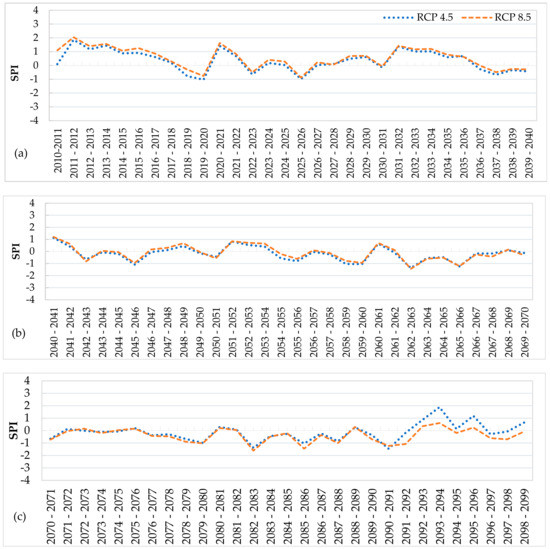
Figure 12.
(a–c) SPI estimation results under RCP 4.5 and RCP 8.5 for the future periods of the 2020s, 2050s, and 2080s in the Kabul River Basin.
Unlike SPI, the RDI includes evapotranspiration to assess drought conditions. According to the analysis of the average drought index from four meteorological stations at a one-year scale (12 months), the RDI forecast in the Kabul River Basin showed moderate and severe droughts under both scenarios (RCP 4.5 and RCP 8.5) for three future periods in the 2020s, 2050s, and 2080s. Figure 13 indicates the estimated annual RDI values for the three future periods (the 2020s, 2050s, and 2080s) under two RCPs (RCP 4.5 and RCP 8.5) scenarios. It was found that drought events will occur more than ten times, with the longest duration of 19 years (228 months) among the 2050s and 2080s periods and intensity of (−1.5) in the years 2065–2066 under both scenarios. Moreover, the second longest duration of drought is forecasted to be in the 2080s period, with a duration of 12 years (144 months) from 2081–2092 and an intensity of (−1.8) and (−1.6) under RCP 4.5 and RCP 8.5, respectively. Additionally, estimated results of RDI show that moderate drought is likely to happen in the years 2019–2020, 2025–2026, 2045–2046, 2058–2059, 2059–2060, 2065–2066, 2079–2080, and 2082–2083, while severe drought would occur once in 2090–2091 under RCP 4.5. Under RCP 8.5, moderate drought will happen in the years 2059–2060, 2065–2066, 2079–2080, and 2085–2086, whereas severe drought will happen in 2082–2083. In the last 2080s periods, RDI shows higher values under both RCPs, showing a tendency similar to the temperature graph, which is taken as the effect of rising temperatures. The average values of RDI in every three future periods indicate that the 2080s will be the driest period, with an average value of (−0.2) and (−0.4) under RCP 4.5 and RCP 8.5, respectively. Since this index takes evapotranspiration into account, the average values of RDI in the 2080s periods under both RCPs are higher than the SPI index.
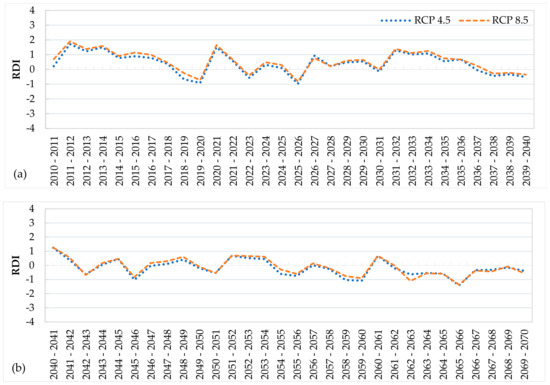
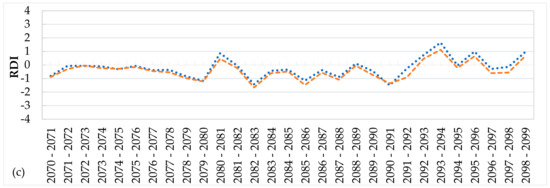
Figure 13.
(a–c) RDI was estimated under RCP 4.5 and RCP 8.5 for the future periods of the 2020s, 2050s, and 2080s in the Kabul River Basin.
The results of DI and its threshold ranges for all meteorological stations are presented in Table 10. According to the results, the drought condition will occur when precipitation is less than 275.1 mm, 921.2 mm, 110.4 mm, and 430.9 mm at Kabul, North Salang, South Salang, and Paghman stations under RCP 4.5, respectively. While, under RCP 8.5, drought conditions will occur when precipitation is less than 256.9 mm, 3003.7 mm, 936.7 mm, and 383 mm at Kabul, North Salang, South Salang, and Paghman stations, respectively. As shown in Figure 14, under RCP 4.5, an extreme drought will happen in the whole Kabul River Basin in the years 2025–2026, 2045–2046, 2058–2059, 2059–2060, 2062–2063, 2079–2080, and 2090–2091, while severe drought years will occur in 2018–2019, 2019–2020, 2022–2023, 2038–2039, 2042–2043, 2065–2066, 2076–2077, 2078–2079, 2082–2083, 2085–2086, 2087–2088, and 2089–2090. Under RCP 8.5, the extreme drought in the KRB will occur in the years 2062–2063, 2079–2080, 2082–2083, 2085–2086, and 2090–2091, whereas, severe drought years will happen in 2019–2020, 2025–2026, 2042–2043, 2050–2051, 2058–2059, 2059–2060, 2065–2066, 2070–2071, 2076–2077, 2077–2078, 2078–2079, 2087–2088, 2089–2090, 2091–1092, 2096–2097, and 2097–2098.

Table 10.
Deciles results for all stations under RCP 4.5 and RCP 8.5.

Figure 14.
(a–c) Deciles raking under RCP 4.5 and RCP 8.5 for the future periods of the 2020s, 2050s, and 2080s in the Kabul River Basin.
NDI analysis was performed annually at four meteorological stations using temperature and precipitation datasets from the RCP 4.5 and RCP 8.5 scenarios, respectively. As per the NDI analysis performed over the Kabul River Basin, it is forecast that the basin could experience a severe drought after 2058. The NDI values estimated considering RCP 4.5 and 8.5 scenarios for the 2020s, 2050s, and 2080s are presented in Figure 15. Based on the NDI values obtained from RCP 4.5, it is identified that the basin will experience severe drought after 2050. The basin is identified as being least affected by drought in the 2020s, with four drought occurrences in the years 2019, 2020, 2038, and 2039, respectively, and in the 2050s, within a span of 30 years, 20 years are identified to experience drought events in the years 2040, 2046–2048, 2050–2052, 2055–2056, 2058–2060, and 2062–2069, respectively. Considering the 4.5 scenarios, the NDI value estimated for the period of the 2050s is −0.39, which indicates that the region is expected to experience a drought event at a moderate level. Analyzing the NDI values obtained for the 2080s, it is identified that 26 years (2070–2080, 2082–2092, and 2095–2097) are expected to experience drought events. With an NDI value close to −1, the period is identified as experiencing severe drought. Similarly, analyzing the RCP 8.5 scenarios projected similar results, indicating that the basin is prone to drought events after 2050. Analyzing NDI values of the 2020s indicates that the basin will be wet and a drought event is expected in the years 2038 and 2039, respectively. The 2050s are expected to experience a disaster with seventeen drought occurrences in the years 2040, 2046–2047, 2050–2051, 2055, 2058–2060, and 2062–2069 respectively. With the NDI value estimated to be −0.12, the period is expected to experience a moderate drought event. With an NDI value of −1.46, the 2080s are expected to experience drought events from 2070–2080 and 2082–2099 based on the RCP 8.5 scenario.
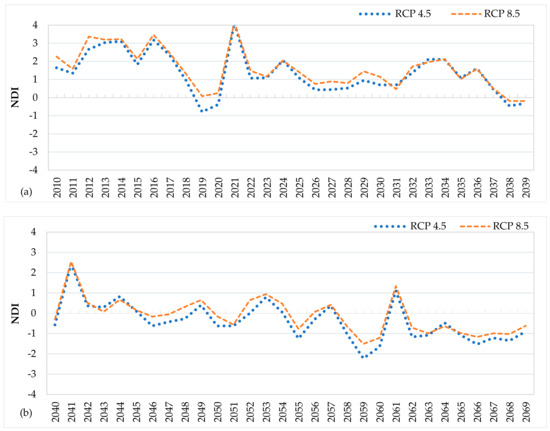
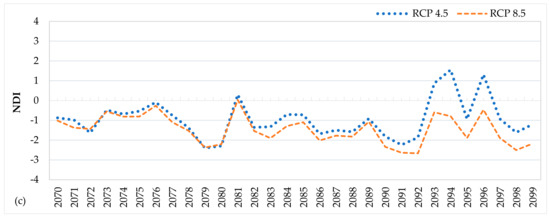
Figure 15.
(a–c) NDI estimation results under RCP 4.5 and RCP 8.5 for the future periods of the 2020s, 2050s, and 2080s in the Kabul River Basin.
3.4.2. Occurrence of Drought at Each Station by SPI, RDI, and NDI
This section evaluates the results of drought analysis based on SPI, RDI, and NDI indexes at four meteorological stations in the KRB. The periods of 2010–2099 were considered to calculate the number of different kinds of drought estimated by SPI and RDI under both RCPs (RCP 4.5 and RCP 8.5). As shown in Figure 16, based on SPI values under RCP 4.5, at Kabul station, extreme drought will occur three times, while severe drought and moderate drought will occur twice and nine times, respectively. Additionally, according to RCP 8.5, at this station, extreme, severe, and moderate drought will happen twice, four times, and ten times, respectively.
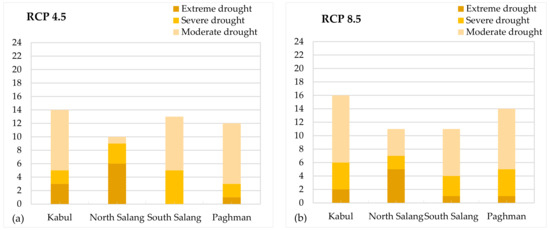
Figure 16.
(a,b) Number of occurrences of drought in each station of the Kabul River Basin for the future periods of 2010–2099 (SPI).
North Salang station has experienced an extreme, severe, and moderate drought six times, three times, and once under RCP 4.5 based on SPI values, while under RCP 8.5 it indicates five times of extreme drought, two times of severe drought, and four times of moderate drought. Moreover, there is no extreme drought at South Salang station under RCP 4.5 based on SPI values, but under RCP 8.5, it indicates one occurrence of extreme drought. Severe and moderate drought under RCP 4.5 and RCP 8.5 are based on SPI values of five and eight times and three and seven times, respectively.
Finally, at the Paghman station, extreme drought will occur one time under both RCPs, but severe and moderate drought will happen two and nine times under RCP 4.5 and four and nine times under RCP 8.5, respectively.
Based on RDI results as illustrated in Figure 17, at Kabul station, extreme, severe, and moderate drought will occur three, once, and eleven times under both RCPs. At North Salang station, there are five times and three times extreme droughts under RCP 4.5 and RCP 8.5, respectively. Severe drought and moderate drought at this station will happen three and two times under RCP 4.5 and three and nine times under RCP 8.5. Under both RCPs, there is no extreme drought at South Salang station, while RCP 4.5 predicts five- to ten times more severe and moderate drought. RCP 8.5 indicates four and nine times severe and moderate drought, respectively. At Paghman station, RCP 8.5 resulted in five times as much severe drought as RCP 4.5, which shows two times as many occurrences of this kind of drought. Furthermore, under RCP 4.5, it is projected that there will be one time and ten times extreme and moderate drought, whereas, under RCP 8.5, there will be one and nine times extreme and moderate drought, respectively. Overall, the RDI index predicts a higher number of moderate droughts under both RCPs than SPI, while SPI predicts more extreme droughts under both RCPs and a severe drought under RCP 4.5 than RDI.
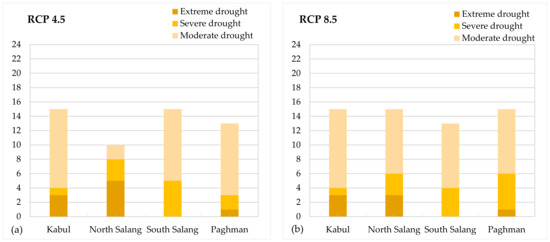
Figure 17.
(a,b) Number of occurrences of drought in each station of the Kabul River Basin for the future periods of 2010–2099 (RDI).
Based on the NDI results illustrated in Figure 18, Kabul station is identified to experience three extreme droughts, six severe droughts, and five moderate drought events, respectively, under RCP 4.5, and RCP 8.5, the station is expected to experience four extreme droughts, eight severe droughts, and seven moderate drought events, respectively. Under RCP 8.5 and RCP 4.5, North Salang station will experience extreme drought six and five times, respectively. Nine and seven severe drought events are expected in North Salang under RCP 8.5 and RCP 4.5 scenarios. Similarly, nine and six moderate drought events are expected in North Salang under RCP 8.5 and RCP 4.5 scenarios, respectively. Extreme, severe, and moderate drought events in South Salang station are expected to hit three, seven, and ten times under RCP 4.5 and 4 (extreme), and eight times (severe and moderate) under RCP 8.5 scenarios, respectively. At Paghman station, RCP 8.5 predicted two extreme drought events, while RCP 4.5 indicates three extreme drought events. Moreover, under RCP 4.5, it is projected that there will be one and nine times severe and moderate drought, whereas, under RCP 8.5, there are four and nine times severe and moderate drought, respectively. Based on the analysis, the NDI forecasted a higher number of moderate, severe, and extreme drought events compared to the RDI and SPI indices.
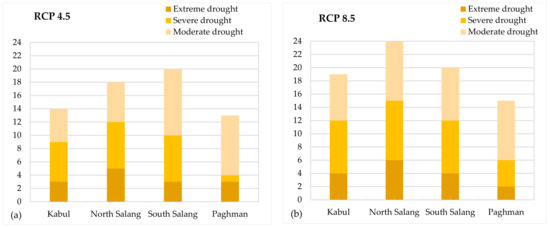
Figure 18.
(a,b) Number of occurrences of drought in each station of the Kabul River Basin for the future periods of 2010–2099 (NDI).
3.5. Distribution Map Droughts by SPI, RDI, and NDI under RCP 4.5 and RCP 8.5 Scenarios
This section evaluates the regional drought analysis at each meteorological station in KRB by using SPI, RDI, and NDI under RCP 4.5 and RCP 8.5 scenarios. The periods of 2010–2099 were divided by 30 years into three future periods such as 2010–2039 (the 2020s), 2040–2069 (2050s), and 2070–2099 (2080s) to make the spatial distribution map of drought by taking the average values of each period from SPI, RDI, and NDI. The SPI showed negative values, predicting a dry climate in the 2050s at all meteorological stations, while the projection shows a wet climate at Kabul and Paghman stations in the 2080s and a dry climate at North Salang and South Salang stations under RCP 4.5. Based on SPI results under RCP 8.5, North Salang and South Salang are projected to have wet areas by the 2020s, whereas, in the 2050s and 2080s, these areas are going to be dry. Paghman and Kabul stations are projected to be wet by the 2050s and 2080s, while there will be a dry climate by the 2020s under RCP 8.5 and SPI values. Overall SPI results under both RCPs showed that in the future, drought will occur at high altitudes, and these areas are projected as dry areas, while the climate at low altitudes under both RCPs is projected to be wetter than at high altitudes, as shown in Figure 19. As drought is caused by low precipitation over an extended period, this fact indicates that precipitation will decrease at the high altitude in this river basin that caused drought.
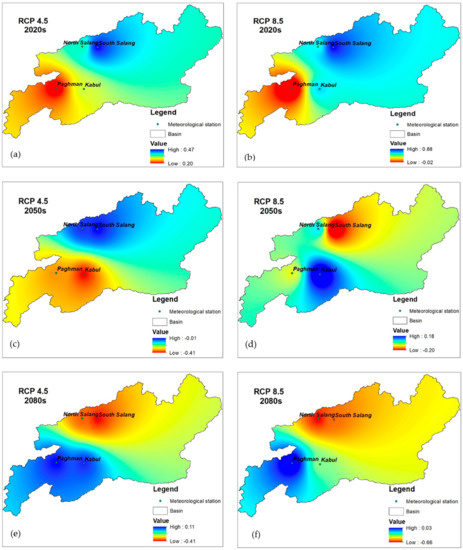
Figure 19.
(a–f) Spatial distribution map of SPI for different future periods in the Kabul River Basin.
Figure 20 shows the distribution map of drought at each meteorological station in the KRB made by the RDI index under RCP 4.5 and RCP 8.5. According to the RDI result under RCP 4.5, Paghman and Kabul stations are projected to be dry in the 2050s, while North Salang and South Salang stations are projected to be wet in the same period. Additionally, in the 2080s, Kabul and Paghman stations are going to be wet under both RCPs, whereas North Salang and South Salang stations will be dry during the same periods under both RCPs. There will be no drought under both indices and RCPs in the 2020s at all stations. Distribution maps under RDI and RCP results also show that high-altitude areas are going to be dry in the future period while low-elevation areas are going to be wet. Although the indices are different, they have a similar tendency for distribution maps in all periods; just the values of the RDI are higher in some periods because it also calculates the evapotranspiration. Figure 19 and Figure 20 show the 30-year drought index distribution maps, which are easy to recognize according to geographical location.
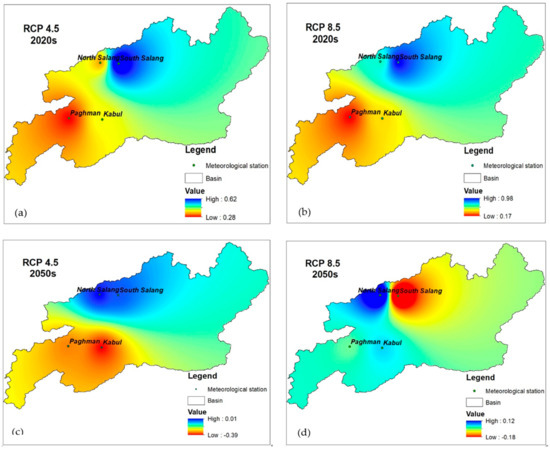
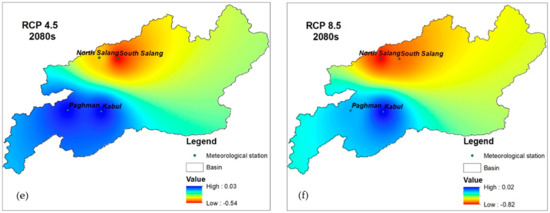
Figure 20.
(a–f) Spatial distribution map of RDI for different future periods in the Kabul River Basin.
Figure 21 shows the distribution map of drought at each meteorological station in the KRB made by the NDI index under RCP 4.5 and RCP 8.5. According to the NDI results under the RCP 4.5 and RCP 8.5 scenarios, all the stations are projected to experience wet conditions in the 2020s, representing a lower probability for the occurrence of droughts. In the 2050s, the spatial distribution map generated considering RCP 4.5 and RCP 8.5 experiences a dry condition, which indicates the possibility of the occurrence of droughts. The values of NDI are identified as being very low, which indicates a mild drought event. The NDI value distribution map for the year 2080s indicates a dry condition, indicating the possibility of the occurrence of moderate to extreme drought in the Kabul River Basin, considering both the RCP 4.5 and RCP 8.5 scenarios. Based on the direct utilization of temperature and precipitation, it is clearly evident that there is a possibility of severe drought in the 2080s.
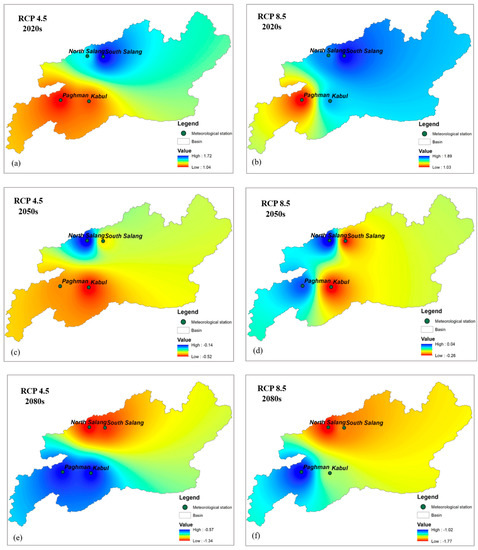
Figure 21.
(a–f) Spatial distribution map of NDI for different future periods in the Kabul River Basin.
4. Discussion
Water resources systems, which are essential for the sustainability of the ecosystem and social economy, are always affected by climate change, especially in arid and semi-arid regions [39]. In many cases, it has been highly evident that the temperature increases while the precipitation decreases significantly due to climate change and often causes major natural disasters, especially drought [36].
Drought is one of the most important and destructive climatic phenomena, the effects of which are usually more important on a regional scale. This destructive phenomenon accounts for more than 15% of natural disasters and is the deadliest natural hazard [39,40].
Studying the drought situation is very valuable, especially in arid and semi-arid regions such as Afghanistan. Kabul River Basin is one of the most important river basins in Afghanistan from a socio–economic and environmental point of view, in which the investigation of drought is considered a very important and vital issue.
While studies have been performed for the drought assessment for this river basin, most of them pertain to analyzing the behavior of the drought in the past. Moreover, in the previous studies, the spatial comparison of the drought was not considered to understand the effects of droughts specific to regions of interest. It was also noted that none of the previous studies considered the impacts of climate change, which is the only cause of natural hazards.
Therefore, this study assessed the meteorological drought for the future under two climate change scenarios using the most commonly used drought indices (SPI and RDI) and NDI. From the results, it can be noticed that there have been 27 moderate droughts, 12 severe droughts, and 10 extreme droughts based on SPI values, and 33 moderate droughts, 11 severe droughts, and 9 extreme droughts based on RDI values under RCP 4.5 during 2010–2099 in the Kabul River Basin. This is while, under RCP 8.5, the estimated values of SPI show 30 moderate droughts, 13 severe droughts, and 9 extreme droughts. Based on RDI’s estimated values, there will be 38 moderate droughts, 13 severe droughts, and 7 extreme droughts during the future periods of 2010–2099. Similarly, estimating NDI values considering RCP 4.5, it is estimated that the basin is expected to experience 30 moderate droughts, 21 severe droughts, and 14 extreme drought events, and under the RCP 8.5 scenario, the basin is expected to experience 33 moderate droughts, 29 severe droughts, and 16 extreme drought events, respectively.
Therefore, under RCP 4.5, there are 49, 53, and 65 droughts based on SPI, RDI, and NDI estimated values on aggregate in 90 years, which implies the frequency of drought is almost once every 2, 1.7, and 1.4 years, respectively. Similarly, under RCP 8.5, there are 52, 58, and 78 droughts under SPI, RDI, and NDI values aggregated in 90 years, which also implies the frequency of drought is 1.7, 1.5, and 1.2 years during 2010–2099. Moreover, based on DI’s estimated values, there will also be 7 extreme droughts and 12 severe droughts under RCP 4.5, 5 extreme droughts, and 16 moderate droughts under RCP 8.5 during 2010–1099. Therefore, there have been 19 and 21 droughts on aggregate in 90 years, which implies the frequency of drought is almost once every 5 years under RCP 4.5 and once every 4.2 years under RCP 8.5. Under RCP 8.5, there are more droughts than under RCP 4.5 in all indices. This is because RCP 8.5 is the highest baseline emissions scenario in which emissions continue to rise throughout the 21st century. Moreover, an assessment of drought in the past also shows the occurrence of 3 extremes, 4 severe, and 8 moderate droughts in this river basin, with a frequency of once every 1.3 years during 1961–1980. Additionally, the frequency of drought in the last decade (1970–1980) is higher than in the first decade (1961–1970). From the comparison of the frequency of droughts in the past and future periods, it can be concluded that this frequency is primarily attributed to climate change, which leads to irregular precipitation behavior.
The significant finding of this study is that in both scenarios and for all drought indices, there will be extreme and severe droughts in the high-elevation areas compared to the low altitudes. This fact indicates the effect of climate change, which causes a significant decrease in precipitation and an increase in temperature. Because of the increase in temperature, the snow and ice that are in the high altitudes will melt, and finally, the high-elevation areas will be bare and dry. Since the melted water goes down, the low-elevation areas will face fewer droughts in the future.
The spatial distribution map also showed that the areas that are located at high altitudes will face meteorological drought, especially in the 2080s. Therefore, the results of this study can help manage drought (high altitudes) and flood (low altitudes) risks in this area and how they affect individuals and communities.
5. Conclusions
This study used a different set of data sources, including the baseline data and bias-corrected output data of the GCMs model, for the evaluation of the meteorological drought in the Kabul River Basin. From the projected precipitation, it was found that the average annual precipitation will decrease by 53–65%, corresponding to the baseline period. Additionally, the average annual maximum and minimum temperatures are likely to increase in the entire river basin under both scenarios in all three future periods. The average maximum temperature will rise from 2.9 °C to 4 °C, and the average annual minimum temperature will increase from 2.7 °C to 3.7 °C in the future period of 2010–2099.
Moreover, according to the drought indices estimated at the KRB from 2010–2099, the predicted values from the SPI and RDI are almost the same in the entire KRB under both scenarios. However, the RDI, with evapotranspiration taken into account, predicted a more moderate drought in future periods than the SPI. It is a fact that RDI considers the PET while SPI does not. To obtain diversity in drought prediction, evapotranspiration was considered necessary to calculate meteorological drought. Meanwhile, the results of DI indicated more drought than SPI and RDI. Results from NDI estimated a furthermore moderate, severe, and extreme drought compared to SPI and RDI, which is due to the consideration of the meteorological parameters directly. Comparing SPI, RDI, and NDI obtained using RCP 4.5 and RCP 8.5 scenarios, it is evident that after the 2050s the probability of the occurrence of drought events in the Kabul River Basin will increase. The NDI considering temperature and precipitation indicates that after 2058, the basin will be affected by drought frequently, and the same is supported by the SPI and RDI indices.
A comparison of distribution maps from drought indices under the three scenarios showed a similar trend with a higher negative value of the NDI, indicating more drought in the high-altitude area than the low-altitude area in the 2050s and 2080s periods. This is an alarming situation, as it would lead to the melting of more snow and pose a threat to future water availability.
As climate change in Afghanistan has caused severe drought, suitable climate change adaptation strategies should be developed to manage the development and management of the KRB’s water resources. Therefore, our results can be directly used for policy-level changes and decision-making to effectively manage the existing available water resources and also to plan additional resources for future growth. This study lacks the availability of observed meteorological data, and it is suggested to use more observation datasets. One of the major limitations faced is the unavailability of observed data downstream of the river basin, which could be resolved by installing more observatory stations that could assist in assessing the hydrological and socio–economic drought under climate change conditions in the Kabul River Basin. Further, the analysis can also be performed by using ERA5-Land precipitation data and WorldClim V2 temperature datasets for deriving the drought indices over the river basin, which could help in obtaining evenly distributed drought indices within the river basin. Not limited to the datasets, integrating the remote sensing images and machine learning techniques could help in better understanding the variation of the agricultural region in the river basin.
Author Contributions
Conceptualization, M.S. and K.S.K.; methodology, M.S. and K.S.K.; software, M.S.; validation, M.S. and K.S.K.; formal analysis, M.S. and S.D.; investigation, K.S.K.; resources, T.S.; data curation, M.S.; writing—original draft preparation, M.S.; writing—review and editing, K.S.K. and T.S.; supervision, K.S.K. and T.S. All authors have read and agreed to the published version of the manuscript.
Funding
This research has been supported by Technische Universität Bergakademie Freiberg with funds of the German Federal Foreign Office.
Institutional Review Board Statement
Not applicable.
Informed Consent Statement
Not applicable.
Data Availability Statement
Data will be made available upon request to the corresponding author.
Acknowledgments
The authors thank the Department of Hydrology and Meteorology, Afghanistan, for their endless support and providing valuable data for the study.
Conflicts of Interest
The authors declare no conflict of interest.
References
- Alami, M.M.; Hayat, E.; Tayfur, G. Proposing a popular method for meteorological drought monitoring in the Kabul River Basin, Afghanistan. Int. J. Adv. Eng. Res. Sci. 2017, 4, 237199. [Google Scholar] [CrossRef]
- Hafez, M.; Abo El-Ezz, S.F.; Popov, A.I.; Rashad, M. Organic amendments combined with plant growth-promoting rhizobacteria (Azospirillum brasilense) as an eco-friendly by-product to remediate and enhance the fertility of saline sodic-soils in Egypt. Commun. Soil Sci. Plant Anal. 2021, 52, 1416–1433. [Google Scholar] [CrossRef]
- Mohammad, A.H.; Jung, H.C.; Odeh, T.; Bhuiyan, C.; Hussein, H. Understanding the impact of droughts in the Yarmouk Basin, Jordan: Monitoring droughts through meteorological and hydrological drought indices. Arab. J. Geosci. 2018, 11, 103. [Google Scholar] [CrossRef]
- Yuan, Z.; Xu, J.; Chen, J.; Huo, J.; Yu, Y.; Locher, P.; Xu, B. Drought assessment and projection under climate change: A case study in the middle and lower Jinsha River Basin. Adv. Meteorol. 2017, 2017, 5757238. [Google Scholar] [CrossRef]
- Wang, J.; Kessner, A.L.; Aegerter, C.; Sharma, A.; Judd, L.; Wardlow, B.; You, J.; Shulski, M.; Irmak, S.; Kilic, A.; et al. A Multi-sensor View of the 2012 Central Plains Drought from Space. Front. Environ. Sci. 2016, 4, 45. [Google Scholar] [CrossRef]
- Rana, S.; Renwick, J.; McGregor, J.; Singh, A. Seasonal prediction of winter precipitation anomalies over Central Southwest Asia: A canonical correlation analysis approach. J. Clim. 2018, 31, 727–741. [Google Scholar] [CrossRef]
- Nakai, J. Food and Agriculture Organization of the United Nations and the sustainable development goals. Sustain. Dev. 2018, 22, 1–450. [Google Scholar]
- Ministry of Energy and Water of Afghanistan. Available online: https://mew.gov.af/en/information-reference-ministry-energy-and-water (accessed on 16 November 2020).
- Baig, M.H.A.; Abid, M.; Khan, M.R.; Jiao, W.; Amin, M.; Adnan, S. Assessing meteorological and agricultural drought in Chitral Kabul river basin using multiple drought indices. Remote Sens. 2020, 12, 1417. [Google Scholar] [CrossRef]
- Jang, Y.K.; Kim, S.D.; Choi, G.W. A Study of Drought Spatio-temporal Characteristics Using SPI-EOF Analysis. J. Korea Water Resour. Assoc. 2006, 39, 691–702. (In Korean) [Google Scholar]
- Vincente, S.M.; Begueria, S.; Lopez-Moreno, J.I. A Multiscalar Drought Index Sensitive to Global Warming: The Standardized Precipitation Evapotranspiration Index. J. Clim. 2010, 23, 1696–1718. [Google Scholar]
- Jang, D. Assessment of meteorological drought indices in Korea using RCP 8.5 scenario. Water 2018, 10, 283. [Google Scholar] [CrossRef]
- Waseem, M.; Ajmal, M.; Ahmad, I.; Khan, N.M.; Azam, M.; Sarwar, M.K. Projected drought pattern under climate change scenario using multivariate analysis. Arab. J. Geosci. 2021, 14, 544. [Google Scholar] [CrossRef]
- Shiru, M.S.; Shahid, S.; Dewan, A.; Chung, E.S.; Alias, N.; Ahmed, K.; Hassan, Q.K. Projection of meteorological droughts in Nigeria during growing seasons under climate change scenarios. Sci. Rep. 2020, 10, 10107. [Google Scholar] [CrossRef]
- Li, H.; Li, Z.; Chen, Y.; Liu, Y.; Hu, Y.; Sun, F.; Kayumba, P.M. Projected meteorological drought over Asian drylands under different CMIP6 Scenarios. Remote Sens. 2021, 13, 4409. [Google Scholar] [CrossRef]
- Bonacci, O.; Bonacci, D.; Roje-Bonacci, T.; Vrsalović, A. Proposal of a new method for drought analysis. J. Hydrol. Hydromech. 2023, 71, 100–110. [Google Scholar] [CrossRef]
- Abbas, S.; Kousar, S. Spatial analysis of drought severity and magnitude using the standardized precipitation index and streamflow drought index over the Upper Indus Basin, Pakistan. Environ. Dev. Sustain. 2021, 23, 15314–15340. [Google Scholar] [CrossRef]
- Kokaly, R.F.; King, T.V.; Hoefen, T.M. Surface Mineral Maps of Afghanistan Derived from HyMap Imaging Spectrometer Data, Version 2; US Department of the Interior, US Geological Survey: Denver, CO, USA, 2013.
- Sidiqi, M.; Shrestha, S.; Ninsawat, S. Projection of climate change scenarios in the Kabul River Basin, Afghanistan. Curr. Sci. 2018, 114, 1304–1310. [Google Scholar] [CrossRef]
- Bannayan, M.; Tojo Soler, C.M.; Garcia, Y.; Garcia, A.; Guerra, L.C.; Hoogenboom, G. Interactive effects of elevated [CO 2] and temperature on growth and development of a short-and long-season peanut cultivar. Clim. Change 2009, 93, 389–406. [Google Scholar] [CrossRef]
- Earth System Grid Federation. Available online: https://esgf-data.dkrz.de/projects/esgf-dkrz/ (accessed on 15 May 2022).
- Gent, P.R.; Danabasoglu, G.; Donner, L.J. The community climate system model version 4. J. Clim. 2011, 24, 4973–4991. [Google Scholar] [CrossRef]
- IPCC. Climate Change 2007: The Physical Science Basis. Contribution of Working Group l to the Forth Assessment Report of the Intergovernmental Panel on Climate Change; Cambridge University Press: Cambridge, UK, 2007. [Google Scholar]
- Drought Indices Calculator. Available online: https://drought-software.com/download/ (accessed on 20 June 2022).
- Sharma, R.C.; Duveiller, E.; Ortiz-Ferrara, G. Progress and challenge towards reducing wheat spot blotch threat in the Eastern Gangetic Plains of South Asia: Is climate change already taking its toll? Field Crops Res. 2007, 103, 109–118. [Google Scholar] [CrossRef]
- Enayati, M.; Bozorg-Haddad, O.; Bazrafshan, J.; Hejabi, S.; Chu, X. Bias correction capabilities of quantile mapping methods for rainfall and temperature variables. J. Water Clim. Change 2021, 12, 401–419. [Google Scholar] [CrossRef]
- Holthuijzen, M.; Beckage, B.; Clemins, P.J.; Higdon, D.; Winter, J.M. Robust bias-correction of precipitation extremes using a novel hybrid empirical quantile-mapping method. Theor. Appl. Clim. 2022, 149, 863–882. [Google Scholar] [CrossRef]
- Vélez-Nicolás, M.; García-López, S.; Ruiz-Ortiz, V.; Zazo, S.; Molina, J.L. Precipitation Variability and Drought Assessment Using the SPI: Application to Long-Term Series in the Strait of Gibraltar Area. Water 2022, 14, 884. [Google Scholar] [CrossRef]
- Buttafuoco, G.; Caloiero, T.; Guagliardi, I.; Ricca, N. Drought assessment using the reconnaissance drought index (RDI) in a southern Italy region. In Proceedings of the 6th IMEKO TC19 Symposium on Environmental Instrumentation and Measurements, Reggio Calabria, Italy, 24–25 June 2016. [Google Scholar]
- Tsakiris, G.; Pangalou, D.; Vangelis, H. Regional drought assessment based on the Reconnaissance Drought Index (RDI). Water Resour. Manag. 2007, 21, 821–833. [Google Scholar] [CrossRef]
- Faiz, M.A.; Zhang, Y.; Tian, X.; Tian, J.; Zhang, X.; Ma, N.; Aryal, S. Drought index revisited to assess its response to vegetation in different agro-climatic zones. J. Hydrol. 2022, 614, 128543. [Google Scholar] [CrossRef]
- Kininmonth, I. Identifying Areas of Agricultural Significance; Report 15/2000; Department of Primary Industries and Regional Development: Perth, Australia, 2000.
- Tigkas, D.; Vangelis, H.; Tsakiris, G. DrinC: A software for drought analysis based on drought indices. Earth Sci. Inform. 2015, 8, 697–709. [Google Scholar] [CrossRef]
- Greve, P.; Roderick, M.L.; Ukkola, A.M.; Wada, Y. The aridity index under global warming. Environ. Res. Lett. 2019, 14, 124006. [Google Scholar] [CrossRef]
- Hargreaves, G.H.; Allen, R.G. History and evaluation of Hargreaves evapotranspiration equation. J. Irrig. Drain. Eng. 2003, 129, 53–63. [Google Scholar] [CrossRef]
- Zarch, M.A.A.; Sivakumar, B.; Sharma, A. Droughts in a warming climate: A global assessment of Standardized precipitation index (SPI) and Reconnaissance drought index (RDI). J. Hydrol. 2015, 526, 183–195. [Google Scholar] [CrossRef]
- Antal, A.; Guerreiro, P.M.; Cheval, S. Comparison of spatial interpolation methods for estimating the precipitation distribution in Portugal. Theor. Appl. Climatol. 2021, 145, 1193–1206. [Google Scholar] [CrossRef]
- Ali, M.G.; Younes, K.; Esmaeil, A.; Fatemeh, T. Assessment of geostatistical methods for spatial analysis of SPI and EDI drought indices. World Appl. Sci. J. 2011, 15, 474–482. [Google Scholar]
- Fang, G.H.; Yang, J.; Chen, Y.N.; Zammit, C. Comparing bias correction methods in downscaling meteorological variables for a hydrologic impact study in an arid area in China. Hydrol. Earth Syst. Sci. 2015, 19, 2547–2559. [Google Scholar] [CrossRef]
- Bruinsma, J. World Agriculture: Towards 2015/2030: An FAO Perspective, 1st ed.; Routledge: London, UK, 2017; p. 444. [Google Scholar]
Disclaimer/Publisher’s Note: The statements, opinions and data contained in all publications are solely those of the individual author(s) and contributor(s) and not of MDPI and/or the editor(s). MDPI and/or the editor(s) disclaim responsibility for any injury to people or property resulting from any ideas, methods, instructions or products referred to in the content. |
© 2023 by the authors. Licensee MDPI, Basel, Switzerland. This article is an open access article distributed under the terms and conditions of the Creative Commons Attribution (CC BY) license (https://creativecommons.org/licenses/by/4.0/).